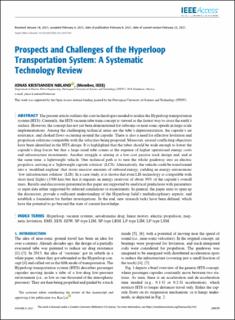| dc.contributor.author | Nøland, Jonas Kristiansen | |
| dc.date.accessioned | 2021-02-23T10:08:28Z | |
| dc.date.available | 2021-02-23T10:08:28Z | |
| dc.date.created | 2021-02-08T22:40:31Z | |
| dc.date.issued | 2021 | |
| dc.identifier.citation | IEEE Access. 2021, 9 . | en_US |
| dc.identifier.issn | 2169-3536 | |
| dc.identifier.uri | https://hdl.handle.net/11250/2729718 | |
| dc.description.abstract | The present article outlines the core technologies needed to realize the Hyperloop transportation system (HTS). Currently, the HTS vacuum tube train concept is viewed as the fastest way to cross the earth’s surface. However, the concept has not yet been demonstrated for subsonic or near-sonic speeds in large-scale implementations. Among the challenging technical areas are the tube’s depressurization, the capsule’s air resistance, and choked flows occurring around the capsule. There is also a need for effective levitation and propulsion solutions compatible with the velocities being proposed. Moreover, several conflicting objectives have been identified in the HTS design. It is highlighted that the tubes should be wide enough to lower the capsule’s drag forces but that a large-sized tube comes at the expense of higher operational energy costs and infrastructure investments. Another struggle is aiming at a low-cost passive track design and, and at the same time, a lightweight vehicle. One technical path is to turn the whole guideway into an electric propulsor, arriving at a ’lightweight capsule solution’ (LCS). Alternatively, the vehicle could be transformed into a ’modified airplane’ that stores massive amounts of onboard energy, yielding an energy-autonomous ’low infrastructure solution’ (LIS). In a case study, it is shown that even LIS technology is compatible with short-haul flights (1500km) but that it requires an energy reservoir of about 30% of the capsule’s overall mass. Results and discussions presented in this paper are supported by analytical predictions with parameters or input data either supported by referred simulations or experiments. In general, the paper aims to open up the discussion, provide a sufficient understanding of the Hyperloop field’s multidisciplinary aspects, and establish a foundation for further investigations. In the end, new research tasks have been defined, which have the potential to go beyond the state of current knowledge. | en_US |
| dc.language.iso | eng | en_US |
| dc.publisher | Institute of Electrical and Electronics Engineers (IEEE) | en_US |
| dc.relation.uri | https://ieeexplore.ieee.org/document/9350309 | |
| dc.rights | Navngivelse 4.0 Internasjonal | * |
| dc.rights.uri | http://creativecommons.org/licenses/by/4.0/deed.no | * |
| dc.title | Prospects and Challenges of the Hyperloop Transportation System: A Systematic Technology Review | en_US |
| dc.type | Peer reviewed | en_US |
| dc.type | Journal article | en_US |
| dc.description.version | publishedVersion | en_US |
| dc.source.pagenumber | 20 | en_US |
| dc.source.volume | 9 | en_US |
| dc.source.journal | IEEE Access | en_US |
| dc.identifier.doi | 10.1109/ACCESS.2021.3057788 | |
| dc.identifier.cristin | 1887892 | |
| dc.description.localcode | This work is licensed under a Creative Commons Attribution 4.0 License. For more information, see https://creativecommons.org/licenses/by/4.0/ | en_US |
| cristin.ispublished | true | |
| cristin.fulltext | original | |
| cristin.fulltext | original | |
| cristin.qualitycode | 1 | |

